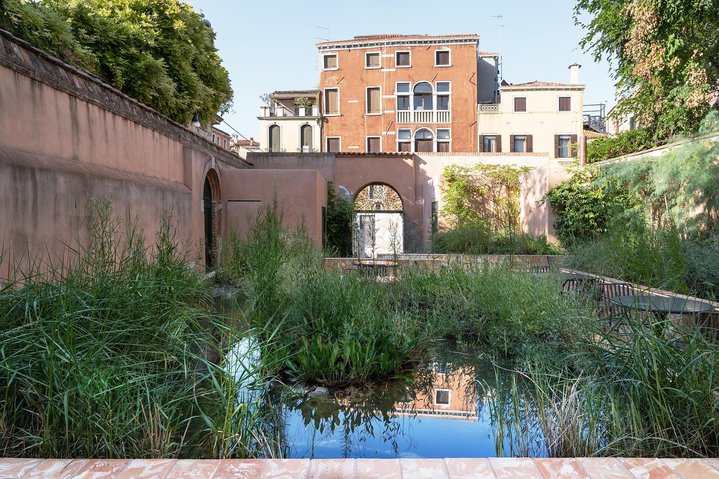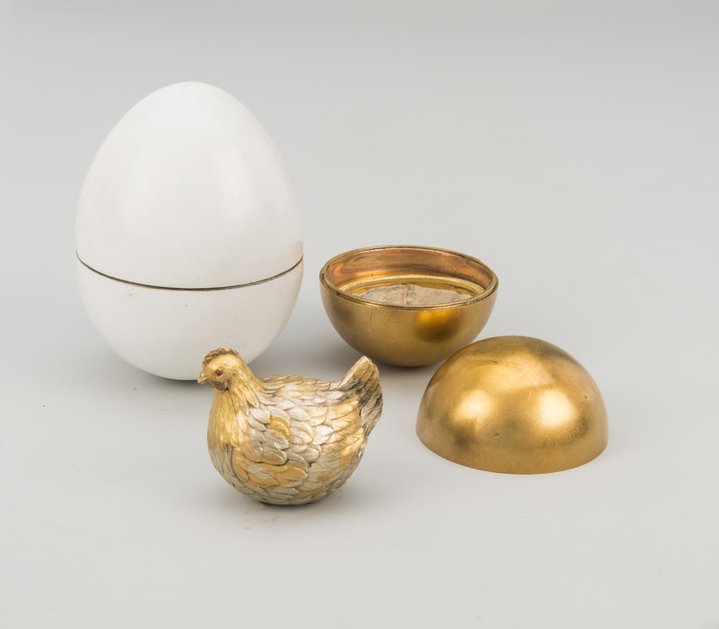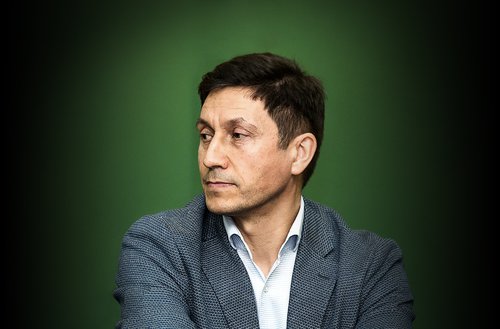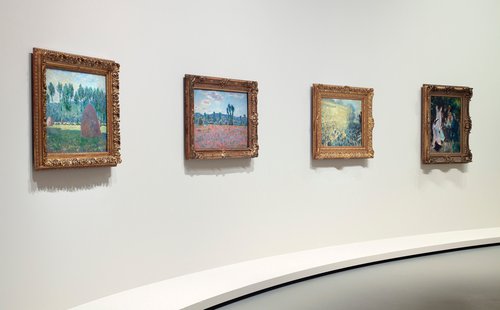The Rise and Fall of Russian Collectors and Patrons

Jeremy Deller. English Magic, 2013. 'We Sit Starving Amidst Our Gold' series. William Morris kicks Roman Abramovich's yacht out of the Venice Lagoon. Fragment of the exhibition in the British pavilion at the 55th Venice Biennale. Photo: Jeremy Deller
Hit hard by sanctions, Russian patrons once courted by the international art community have found themselves out in the cold. Art collections worth hundreds of millions of dollars and assembled over several decades have been seized. What does the future hold for them?
For Russian art and Russian art collectors, just before the invasion of Ukraine in 2022, freed from the shackles of the pandemic which was by then receding, the year had got off to a buzzing start and it showed no signs of what lay ahead. The blockbuster exhibitions of the Ivan Morozov collection at the Fondation Louis Vuitton in Paris and the Fabergé show at the Victoria and Albert Museum in London were in full swing, promoting Russian art to audiences abroad. The House of Culture GES-2, set up with funds by billionaire Leonid Michelson, had just opened with great fanfare in Moscow; meanwhile, Roman Abramovich and Daria Zhukova's Garage Museum for Contemporary Art was in the middle of a major reconstruction of the Hexagon pavilion in Gorky Park, which was about to host a retrospective by the German performance artist Anne Imhof. Alongside all of these activities and achievements there were significant numbers of Russian collectors and patrons of the art contributing time and funds to acquisitions and cultural projects on the boards of trustees of many Western museums, from London's Tate to New York's Museum of Modern Art.
This situation changed radically after February 24th last year, when, in response to the start of what was called in Russia a ‘special military operation’ in Ukraine, Western countries quickly began to impose sanctions on Russian oligarchs, some of the country’s most visible art patrons. Almost overnight sanctioned patrons simply disappeared from the lists of museum trustees in both the US and the UK. Petr Aven was forced to leave the board of trustees of the Royal Academy of Arts in London and the museum has also returned his charitable contribution for the exhibition ‘Francis Bacon: Man and Beast’. The future of the collector's private museum in Riga is now unclear, as his assets in the United Kingdom have been frozen, and in spring last year the press in Latvia was even discussing the possibility of revoking his citizenship. Russian billionaire Vladimir Potanin, who came under US sanctions in December, was also asked to leave the board of trustees of the Guggenheim Museum in New York. According to unofficial accounts, most patrons with Russian passports were affected by these strict measures and asked to leave museums boards, even if they were not subject to individual sanctions.
Some institutions initially tried to find ways of carrying on working with the support of their Russian benefactors such as the Israeli Holocaust remembrance centre ‘Yad Vashem’, whose board signed a petition to the US asking that sanctions not be applied to Russian oligarch Roman Abramovich. Later, however, when Abramovich did come under UK sanctions, the museum issued a press release announcing the suspension of its strategic partnership with the philanthropist.
Elsewhere, though, the public were hostile and demonstrative. In May, Italian left-wing activists staged a rally outside Palazzo Zattere, the Venetian venue of the V-A-C Foundation founded by Leonid Mikhelson. Young people from the Global Project hung banners on the facade of the building demanding the expropriation of the property of Russian oligarchs, held a rally and after a few hours dispersed. “Everything ended peacefully,” said V-A-C representatives in Venice.
As soon as the sanctions had been announced, a wave of property seizures quickly began – yachts, villas and airplanes – sweeping across Western Europe and the USA, and this included large numbers of works of art which were discovered during official searches. It was not unprecedented. Oleg Deripaska has been under US sanctions since 2018, and in the autumn of 2021, among the items seized from his homes in New York and Washington, D.C., were art treasures, including a painting by Diego Rivera (1886–1957). And when squatters took over a London mansion believed to belong to Deripaska, they published a video of the interiors where you can see on display a painting by Franz Roubaud (1856–1928) and an abstract sculpture by Barbara Hepworth (1903–1975). In the Summer of last year British businessman Graham Bonham-Carter was accused of trying to smuggle works of art bought by Deripaska at auction in New York to London and of providing false information to the auction house to conceal the name of the real owner. The US authorities are currently seeking Bonham-Carter's extradition.
Buying art through third parties to circumvent sanctions is an old, proven scheme. For example, the Russian billionaire brothers Arkady and Boris Rotenberg came under US sanctions in 2014, but that did not stop them from continuing to buy works of art, including paintings by Impressionists and 20th-century artists at auction.
In July 2022, US authorities discovered a Fabergé egg on a yacht seized from Russian oligarch Suleiman Kerimov. This was revealed by US Deputy Attorney General Lisa Monaco at the annual security conference in Aspen, Colorado. "Let's get to the juicy stuff: the yachts. We found some really interesting things... we recovered a Fabergé – or alleged Fabergé egg,” the Guardian quoted her as saying. Although debates ranged later online whether the egg was genuine or fake.
Alisher Usmanov's name figured prominently in press reports about searches for assets which could be seized. First, according to Der Spiegel, German investigators found jewellery, paintings and no less than what they claimed to be four Fabergé eggs at his villa in Rottach-Egern in Bavaria, then they seized paintings, including one by Marc Chagall (1887–1975), during a search of the superyacht Dilbar owned by the oligarch's sister. However, regarding the Fabergé, Usmanov's representative said they were simply gifts of no particular value to friends in Uzbekistan. It now falls to the German authorities to check the authenticity and decide what to do with them. By law, the oligarch was required to declare his property, but as Usmanov did not do this, Germany could temporarily confiscate his real estate, yachts and valuables.
Two paintings from the Morozov exhibition were seized in France in April 2022: Self-Portrait by Pyotr Konchalovsky (1876-1956) belonging to Petr Aven, and Valentin Serov's (1865–1911) portrait of Timofey Morozov, which belongs to MAGMA, a Geneva-based Avant-Garde Museum founded by Vyacheslav (Moshe) Kantor. There has been no news about the fate of these paintings to date, a year after their seizure, and the assumption is now that they will stay in France as long as their owners remain under sanctions. There is a similar story around two Fabergé objects previously on show at the exhibition at the V&A in London, which have been linked to Viktor Vekselberg. After the exhibition ended in May, the Hen Egg and a 1913 gold enameled cigarette case from the collection of the Fabergé Museum in St. Petersburg were not returned to the official owner, Lamesa Arts Inc. registered in Panama and owned by Vekselberg. The British Treasury will now decide on whether the pieces are to be returned to the owner or not.
Before the tragic events of last year, Russian art collectors were active on the international art market, according to a report by Deloitte and ArtTactic they spent around $1-1.5 billion on European and American works of art every year. Whether or not this figure is close to the truth, (hard to understand how it can be verified), their withdrawal from the international art market will be felt. Dedicated Russian art auctions have been cancelled and departments at the London and New York auction houses formerly working with major Russian collectors buying in all areas of the art market, especially Impressionist and Modern art, have been significantly downsized. A considerable number of wealthy Russian businessmen with a history of patronage inside Russia had been increasingly focusing their cultural and art philanthropy outside Russia over recent years, it was a way of distancing themselves from Russia. Yet, generous contributions to museums, grant programs abroad, even obtaining Western citizenship and a willingness to set up a private museum abroad have not saved Roman Abramovich, Petr Aven and Mikhail Fridman, from Western sanctions. On the other hand, Odessa-born immigrant Len Blavatnik, who in the past did business in Russia and kept contacts with the Russian political elite, has not been ostracized. Not only are his donations accepted in the UK, but his name was also given to the Swatch House at Tate Modern and a wing in the National Portrait Gallery.
Other Russian patrons have recently focused on developing cultural and educational projects in the CIS. For example, Shalva Breus, founder of the Kandinsky Prize and former publisher of ArtChronika magazine, bought a historic 19th century hospital building in central Tbilisi and plans to turn it into a contemporary art museum. In the past two years, Alisher Usmanov's Foundation for Art, Science and Sport has developed large-scale activities in Uzbekistan including a program to preserve modernist architecture in Tashkent, the restoration of the Romanov Palace, a plan for the development and reconstruction of an art museum in the city. And recently Uzbekistan asked the EU to lift sanctions against the billionaire.
This article was first published in Russian in the December-2022 issue of The Art Newspaper Russia















